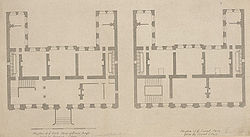27:
19:
94:
leased the house in the mid 18th century and from 1764 to 1783 it was the
Spanish embassy. However, the locality was rapidly falling from favour with the aristocracy, making the demise of the house more or less inevitable, and by the end of the 18th century it had been demolished. There is now a
68:
attributed this event to "the carelessness of the rascally French servants". A replacement house was soon built. It had three main storeys above an arched basement and was 104 feet (32 metres) wide. The subtle but lively façade featured
64:. No drawings of this version survive. At some point it was let for use as the French embassy, and on 26 January 1713 it burned to the ground, while the Ambassador, the Duc d'Aumont, was entertaining.
208:
57:
169:
91:
116:
76:
and a phoenix above the front door. The architect is unknown, but may have been French. The staircase walls were painted by the
96:
26:
163:- another London mansion, which was also briefly known as Powis House before assuming its final name.
50:
46:
131:
112:
70:
160:
85:
65:
61:
202:
132:"Queen Square and Great Ormond Street Pages 553-564 Old and New London: Volume 4"
18:
184:
171:
73:
42:
81:
77:
38:
56:
The first version of Powis House was built in the 1690s for
209:Former houses in the London Borough of Camden
8:
138:. Cassell, Petter & Galpin, London, 1878
22:The second version of Powis House, c. 1714.
25:
17:
123:
58:William Herbert, 2nd Marquess of Powis
7:
92:Philip Yorke, 1st Earl of Hardwicke
45:. It stood on the northern side of
14:
37:was an 18th-century mansion in
1:
97:Great Ormond Street Hospital
30:Ground and first floor plans
225:
111:by David Pearce, (1986)
95:small access street to
136:British History Online
31:
23:
29:
21:
185:51.52194°N 0.11972°W
99:called Powis Place.
181: /
47:Great Ormond Street
190:51.52194; -0.11972
32:
24:
109:London's Mansions
216:
196:
195:
193:
192:
191:
186:
182:
179:
178:
177:
174:
148:
147:
145:
143:
128:
60:, member of the
224:
223:
219:
218:
217:
215:
214:
213:
199:
198:
189:
187:
183:
180:
175:
172:
170:
168:
167:
161:Newcastle House
157:
152:
151:
141:
139:
130:
129:
125:
105:
86:Giacomo Amiconi
80:painter of the
49:, not far from
12:
11:
5:
222:
220:
212:
211:
201:
200:
165:
164:
156:
153:
150:
149:
122:
121:
120:
119:
104:
101:
66:Jonathan Swift
62:Herbert family
13:
10:
9:
6:
4:
3:
2:
221:
210:
207:
206:
204:
197:
194:
162:
159:
158:
154:
137:
133:
127:
124:
118:
117:0-7134-8702-X
114:
110:
107:
106:
102:
100:
98:
93:
89:
87:
83:
79:
75:
72:
67:
63:
59:
54:
52:
48:
44:
40:
36:
28:
20:
16:
166:
140:. Retrieved
135:
126:
108:
90:
55:
51:Queen Square
34:
33:
15:
188: /
142:24 November
35:Powis House
173:51°31′19″N
103:References
71:Corinthian
74:pilasters
203:Category
176:0°7′11″W
155:See also
78:Venetian
43:England
115:
82:rococo
39:London
144:2022
113:ISBN
205::
134:.
88:.
84:,
53:.
41:,
146:.
Text is available under the Creative Commons Attribution-ShareAlike License. Additional terms may apply.

